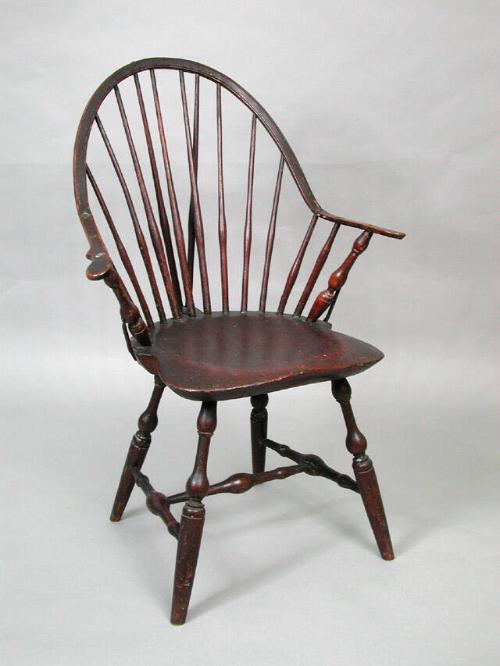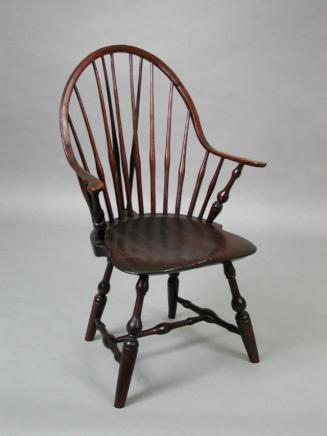Armchair
Furniture MakerMade by
Amos Denison Allen
(American, 1774 - 1855)
Date1797-1800
MediumPine, maple, ash, oak, red paint
DimensionsPrimary Dimensions (overall height x width x depth): 37 15/16 x 24 5/8 x 21 1/2in. (96.4 x 62.5 x 54.6cm)
ClassificationsFurniture
Credit LineBequests of Roderick Bissell Jones and Mrs. Florence Cable Canfield, by exchange and museum purchase
Object number1986.187.0
DescriptionRed, painted armchair in the Windsor style, with a continuous bow-back, bracing spindles, turned posts, legs, and stretchers, and a plank seat. The continuous bow back consists of a bow, or a wooden stick, bent in an arch that sweeps forward at each side to form an arm and flat scrolled handhold. The front of the bow is flat with a beaded edge. The top of the arms are flat and each handhold has a small spur behind the scroll. The bow is supported by twelve swelled spindles of varying height, two turned posts at either side, and two swelled bracing spindles in a "V" at the back of the seat. The swelled spindles have a bulge in the lower half and are tapered up to the top. The posts are turned with wide baluster forms. The back of the armchair is slanted back; the spindles and posts are joined to the seat in a semi-circular arrangement. The bracing spindles are joined to the semi-circular seat extension at the back of the chair. The pine plank seat is shield-shaped and has a saddled seat, or contoured upper surface with a raised ridge at the front center, with a flat surface at the back where the spindles and posts join the seat. The sides and back of the plank are curved and chamfered, or cut at an angle. Below the seat are four turned legs that are raked, or slanted out from top to bottom; each is turned with wide baluster and ring forms over a tapered ankle and foot. Each side of the chair has a single stretcher with an ovoid form in the center flanked by a tapered form. Between the stretcher is a single medial stretcher with the same turnings.
Condition: Each post has a straight iron brace screwed into the side that extends down and back to the side of the seat. The left bracing spindle has dislocated from the mortise in the seat extension. The two right most projecting sides of the plank seat have split off from the seat and been glued and nailed back on. The swelled spindle, second from the right, has been tenoned through the plank seat; this spindle is possibly replaced. Two of the tenons through the top of the bow have disintegrated. Nails have been added to the back side of the plank seat to reinforce the joint where the spindles join the seat. The tenon at the bottom of the right post has been repaired with a screw and a wedge inserted through the underside. The chair has dark red paint over a light green paint, over black paint. The red paint is flaking, revealing the green or black paint below.
Design and Construction Details: The bow is supported on a through tenon at the top of the posts and all but four spindles; four of the spindles are only tenoned up into the bow. The through tenons have a small wedge through the end of the tenon. Each spindle is tenoned down into the spindle platform; the bracing spindles are tenoned down into the rounded seat extension. Each post is tenoned down through the plank seat. The seat and seat extension are constructed of a solid plank of wood and supported on a through tenon at the top of each leg. The side stretchers are tenoned into the lower legs. The medial stretcher is tenoned into the side stretchers. All the tenons are inserted at an angle, where necessary, to give the proper slant to the bow and each of the spindles and legs.
Condition: Each post has a straight iron brace screwed into the side that extends down and back to the side of the seat. The left bracing spindle has dislocated from the mortise in the seat extension. The two right most projecting sides of the plank seat have split off from the seat and been glued and nailed back on. The swelled spindle, second from the right, has been tenoned through the plank seat; this spindle is possibly replaced. Two of the tenons through the top of the bow have disintegrated. Nails have been added to the back side of the plank seat to reinforce the joint where the spindles join the seat. The tenon at the bottom of the right post has been repaired with a screw and a wedge inserted through the underside. The chair has dark red paint over a light green paint, over black paint. The red paint is flaking, revealing the green or black paint below.
Design and Construction Details: The bow is supported on a through tenon at the top of the posts and all but four spindles; four of the spindles are only tenoned up into the bow. The through tenons have a small wedge through the end of the tenon. Each spindle is tenoned down into the spindle platform; the bracing spindles are tenoned down into the rounded seat extension. Each post is tenoned down through the plank seat. The seat and seat extension are constructed of a solid plank of wood and supported on a through tenon at the top of each leg. The side stretchers are tenoned into the lower legs. The medial stretcher is tenoned into the side stretchers. All the tenons are inserted at an angle, where necessary, to give the proper slant to the bow and each of the spindles and legs.
Status
On view














